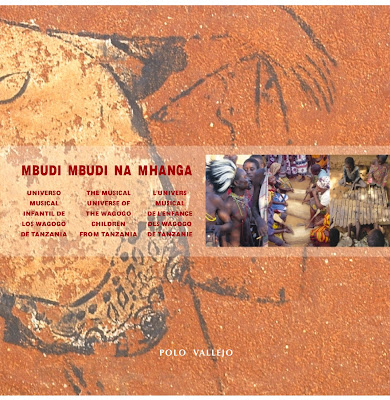17 Dec, 2008
Polo Vallejo: The Musical Universe of the Wagogo Children from Tanzania
Posted by: Redaktion In: Reviews
“There´s no one can resist dancing to this music”:
MBUDI MBUDI NA MHANGA. The Musical Universe of the Wagogo Children from Tanzania (2004)
More information about the book: [see here]
A true gem of a book is the publication “Mbudi Mbudi Na Mhanga. The Musical Universe of the Wagogo Children from Tanzania” of the spanish etnomusicologist, educator and composer Polo Vallejo. Once holding it in your hands I promise, that you will fall in love with it. Although it seems a quite simple word to discribe this complex strucured and tasteful designed book, it is at all just beautiful.
Even more captivating is the polyphonic singing and the wealth of the musical tradition of the wagogo covering songs of amusement, instrumental xylophone-pieces, music of initiation rites and fable-songs.
 |
| Von Rezensionen |
There are varios aspects, why it is a pleasure to read Polo Vallejos approximation to the music of the children of the east-african state tanzania. First of all, when you open the book and turn some pages, it will welcome you with great pictures of the african savannah, as well as portrait-photos showing wagogo people within their lifes. The pages are designed in warm colours. There are drawings of african animals made by the wagogo children and artistic graphics integrated.
“Mbudi Mbudi Na Mhanga”, which means “The Bat and the Orycteropus”, is actually the name of a children’s tale of the Wagogo. Written in three languages (spanish, english and french) the phrases are clearly devised and therefor can be easily understood also by young readers or rather can be read to someone.
There are three main chapters, that examine (1) the wagogo habitants and their culture, (2) the world of children´s music and (3) the musical system. Chapters (2) and (3) though of an etnomusicological background, allow every reader to understand the different musical aspects of the wagogo music. Each chapter is divided in well proportionated articles, where the most important facts on subjects are concentrated like social organization, religious beliefs and rites, life´s stages, repertory, musical training, instruments and musical structures.
Further the articles are punctuated by ten episodes out of the field logbook of Polo Vallejo. One entry tells about the excitement when introducing a multi-track recorder, that isolates one voice. This recording technic permits the individual study of the complex rhythmical patterns. A fourth chapter of the book (4) contains more than 60 valuable transcriptions of children songs and games, girls, boys and collective songs.
The book not only discovers the music of the wagogo, but also intents to raise an understanding of what wagogo life is about. Acompained by two CD´s with more than 60 different songs recorded during fieldworks between 1995 and 2001 and further 40 tracks with pulse demonstrations the book permits a look inside the musical cosmos of a fascinating african musical tradition. Like the Sangura, the rabbit, in the tale “Mbudi Mbudi Na Mhanga” says: “There´s no one can resist dancing to this music”.
Further pulications:
2008: [Patrimonio Musical Wagogo (Tanzania): contexto y sistemática]

